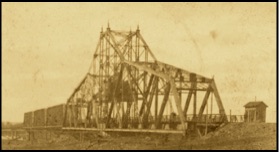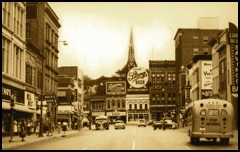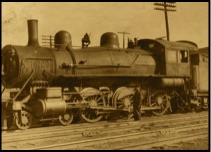Historical Society of
Pottawattamie County
County Seat Council Bluffs, Iowa



Council Bluffs Moved the Mail: The Railway Mail Terminal...
By retired RMS clerk Robert Warner, Sr. and Richard Warner
At first thought Council Bluffs may seem as though it’s always been somewhat detached from the world at large, nestled away in the vastness of the great plains. For many decades, though, in a building surrounded by railroad tracks in the south end of the city, thousands of pieces of mail bear- ing the names of places a county, a few states, or even an entire world away could be found.
In the days before cell phones, faxes, and e-mail it was solely up to the U.S. Mail to hold the nation together. And if the mail was indeed the life-blood of the country, than Council Bluffs was its heart and pulse.
Just the numbers themselves were staggering. As early as 1910 it was reported “Council Bluffs was handling more mail than any city it’s size and as much mail as any city of any size.” Up to twenty five million pieces of mail a year passed through, bearing the names of countless destinations, from the tiniest villages to the enormous populations centers. Each piece had to be recognized instantly by the Council Bluffs mail terminal workers and in a split second sent off in the right direction.
Mail had been handled at Council Bluffs since the Union Pacific established the transfer yards in 1877, but there was no attempt to sort it; it was just unloaded from trains arriving from the east onto the westbound trains, and vice versa.
Beginning in the 1860’s more and more mail was sorted right on the trains while they moved by clerks of the Railway Mail Service in specially designed cars. While this worked well for letters and periodicals the advent of parcel post dramatically increased the bulk of the mail and made the establishment of mail terminals a necessity.
Council Bluffs’ terminal started in a red brick building leased from the Union Pacific, adjacent to the railroad’s Transfer Hotel. The city’s strategic location amongst the major railroads of the West made it the natural spot through which to move the mail. The terminal quickly grew to become one of the most prominent, by 1937 rank- ing as the third largest in the entire country.
The terminal operated around the clock, 7 days a week. It became one of the city’s largest single employers, particularly during the Christmas mail rush, in which up to 400 extra staff would be hired. The World War II years saw growing amounts of mail and less men to work it. As was the case with other formerly male occupations women came to the rescue. A separate addition was built dubbed the “WAC shack.” The new female employees began sorting the mail just like their male counterparts, but in their own separate workspace.
The impact of such a facility on a city’s economy could be quite significant, a fact that was understandably not lost on civic leaders of other communities, and the threats to move all or part of the operation from Council Bluffs were frequent.
The most serious threat came 70 years ago when plans were announced to “consolidate mail sorting and handling operations” by closing the Council Bluffs terminal and combining its operations with a terminal in Omaha.
Citing a potential devastating effect on the local economy, city and business leaders quickly rallied to save what had by then become one of the city’s largest industries. The Junior Chamber of Commerce sponsored a radio program to raise opposition to the move, Iowa Senator Louis Murphy and General Matthew Tinely traveled to Washington to call on Postmaster General Farley personally, while Bluffs Mayor Guilfoyle set into motion a 7 person local committee to monitor the issue and to devise methods to fight it.
The battle took three years but was resolved in Council Bluffs’ favor. To counter criticism that the facility was outmoded the Union Pacific razed two thirds of the once grand but now vacant Transfer Hotel to make way for a modern concrete and steel fireproof structure to lease to the mail service; only the north wing of the old hotel was retained for use as a lunch room and lockers for railroad employees. The new terminal was dedicated in October of 1938.
To facilitate the heavy volume of mail an elaborate conveyor system
nearly a quarter mile in length was installed in 1951. Bags and parcels unloaded from mail cars were placed onto a belt which carried them to a platform where they were loaded into carts; these were hooked onto an over- head chain which pulled them to an- other conveyor belt.
The most difficult part was the sorting process. Each mail clerk had to know 5,000 to 10,000 post offices by memory. Each piece of mail up had to trigger instant recognition of which rail line that destination was on and in which sack that letter had to be placed to get it on to where it was going. Given the huge volumes of mail processed in Council Bluffs this had to be done quickly and efficiently, and was something the post office took very seriously. Each clerk was given a timed test every six months.
Council Bluffs’ mail terminal resiliently survived the annual Christmas rushes, political battles, pressures of two world wars, and even a flood, but finally met its match with the five digits called the zip code. In 1965 it was announced that the postal service’s plan to speed the ever growing volumes of mail would eliminate the large mail terminals like the one in Council Bluffs where mail was sorted by hand in favor of regional sectional centers outfitted with automated equipment that could electronically read zip codes
and mechanically sort the mail.
The terminal was closed in 1966. The last remaining portion of the old Transfer Hotel was torn down shortly afterward but the 1938 building that housed the mail sorting operation still stands today.
Despite the closure of the terminal and the elimination of the railway post offices in the 1970's a considerable volume of mail continues to be moved by passenger trains today. Amtrak, however, has recently announced cancellation of it's first class and bulk mail contracts in an effort to speed it's service by eliminating the time taken to load and unload mail. When this change takes place it will mark the first time since 1831 that mail hasn't been carried on passenger trains. Bulk mail will continue to be carried by freight trains.